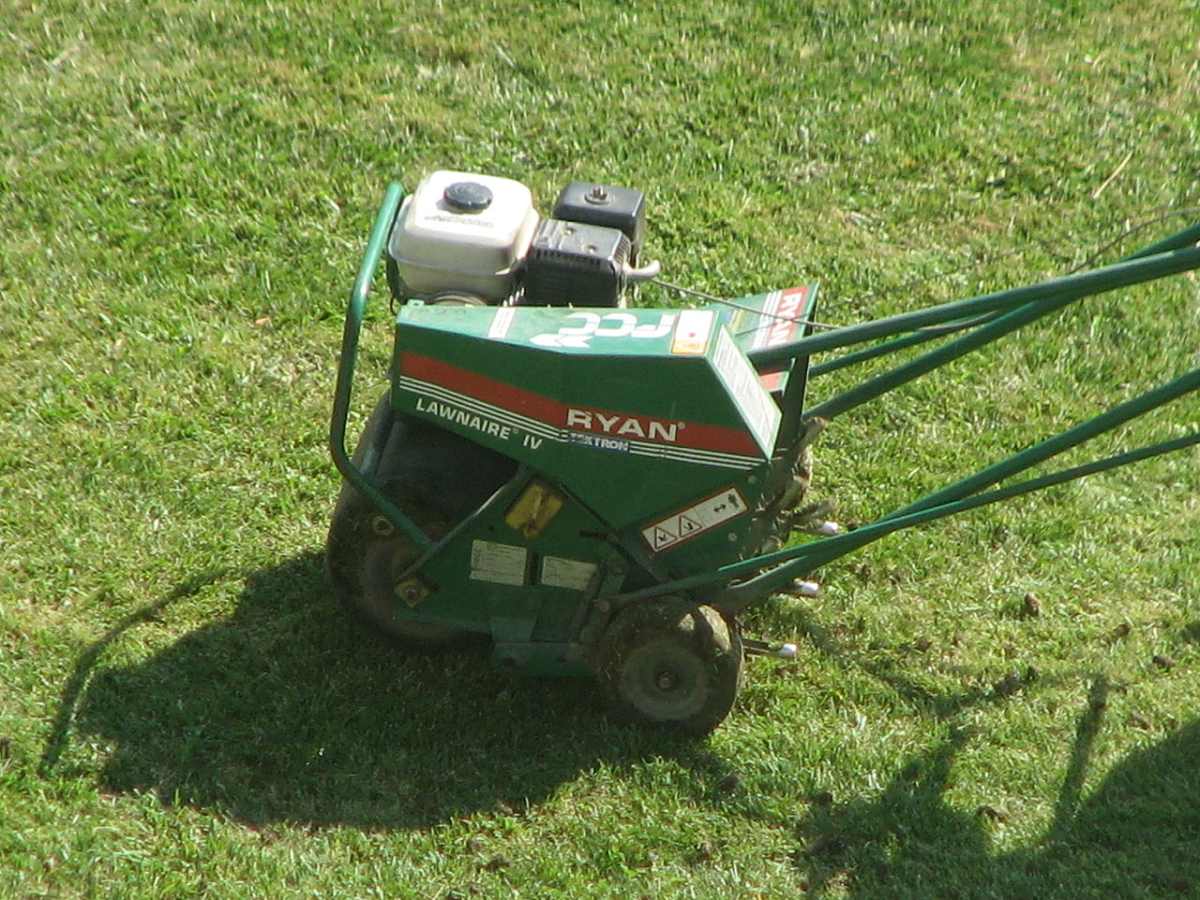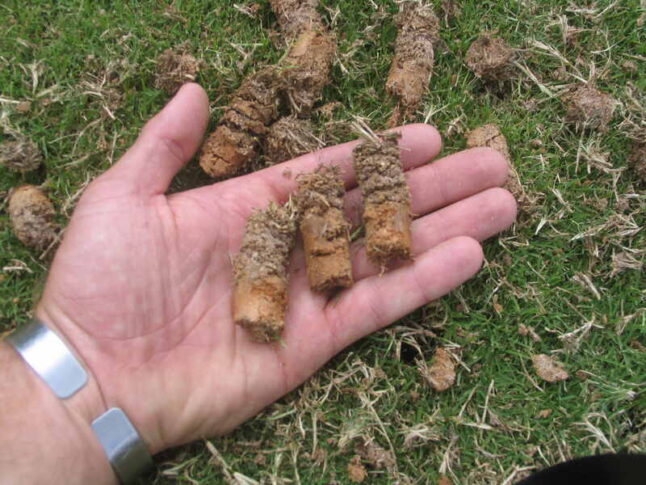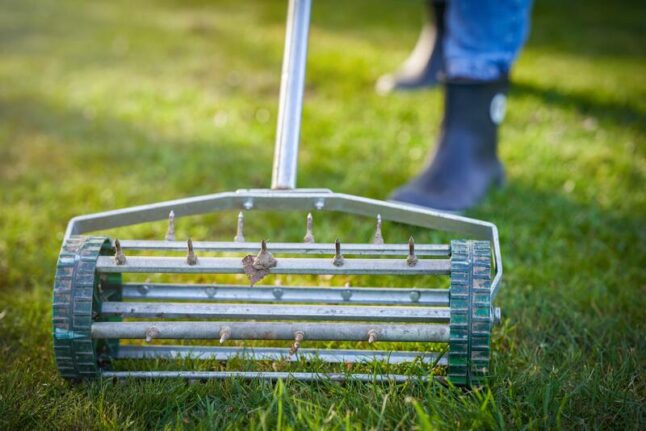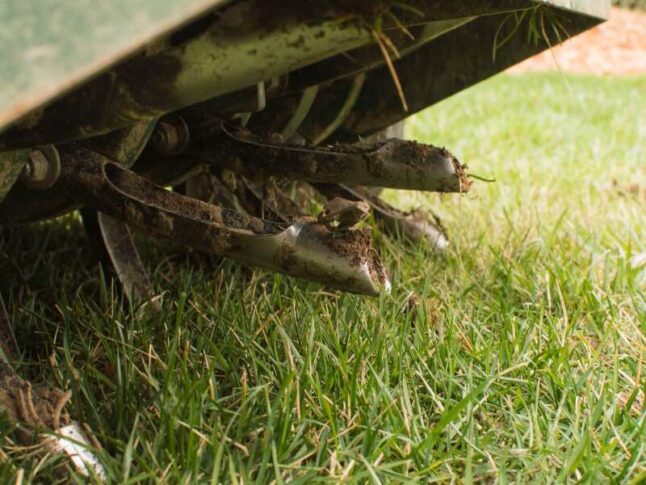
You should aerate your lawn in Fargo every two years in late summer or early fall, or every year if your lawn gets a lot of use. You can aerate it yourself, which requires preparation and physical labor, or hire a lawn care company, which averages $144.
Why aerate? Fargo’s clay soil becomes compacted easily, making it difficult for grass roots to expand, grow, and absorb water, sunlight, fertilizers, and nutrients. Aeration creates small holes in your lawn, loosening the soil and allowing your grass to flourish.
Key Takeaways
Lawn aeration relieves compacted soil. Aeration equipment makes small holes in your turf, allowing grass roots to grow and water and nutrients into your soil.
Aerate your lawn in 7 easy steps. Choose a tool, mow, water, flag sprinkler heads, aerate, then add soil amendments, and overseed.
Aerate during peak growing season. You likely have cool-season grass, which needs aeration in late summer to early fall. Warm-season grass needs aeration in the summer.
Aerate every two years. Fargo’s heavy clay soil means the soil compacts easily. If your lawn receives heavy foot traffic, aerate every year.
What is Aeration?
Lawn aeration is the process of relieving a compacted lawn by punching small holes into the soil. It gives grass roots room to grow and allows the life-giving water, sunlight, and nutrients to seep into the soil, nourishing your grass.
All soil eventually becomes compacted, but some factors hasten the process, including:
- High clay content in your soil
- High foot traffic, as you can imagine, presses the soil down under the weight of the people walking or playing and pets on your grass.
- If your lawn started as sod, the thin soil of the sod was probably placed directly on top of the existing, more compacted soil. The mismatch of soil types makes it difficult for nutrients to seep through. New constructions have the added component of workers walking on the lawn, compacting it more.
Types of Aeration
There are two types of lawn aeration: core aeration and spike aeration.
Core Aeration

Core aeration removes small soil plugs from your yard using hollow tines. It’s like a hole punch for your lawn. Plugs are about 2 to 4 inches deep, 0.5 to 0.75 inches in diameter, and 2 to 3 inches away from each other. They should be left where they fall because they become an excellent topdressing and help decompose thatch.
Core aeration is best for lawns that:
- Are heavily compacted
- Experience heavy foot traffic
- Haven’t been aerated in years
- Recently underwent construction
- Have heavy clay soil
- Are medium or large
- Have a severe thatch problem
The pros of core aeration:
✓ Long-lasting: The hollow tines remove soil, creating holes that allow roots to grow deeper and grass to grow denser.
✓ Eco-friendly: Reduced compaction means less runoff and decreases the need for water and fertilizer.
✓ Increases the visual appeal of your lawn in the long term
✓ Cores act as compost, so you can simultaneously aerate and top-dress your lawn
✓ Decreases the need to dethatch your lawn
✓ Dense grass growth prevents weeds from invading your lawn
The cons of core aeration:
✗ Aerating too often or in the wrong season stresses your lawn.
✗ Visually unattractive before holes fill in.
✗ Fallen plugs look messy before they decompose.
✗ If pre-emergent herbicide is not applied, weeds can sprout in holes.
Types of Core Aerators
There are three kinds of core aerators.
- Manual Core Aerator
A manual core aerator looks similar to a trident. You stab the tool, push it in with your foot, and then pull it out.
Pros: the cheapest core aeration option, and it’s perfect for spot treatment
Cons: It takes longer and requires the most manual labor
Manual Core aerators are best for: Small lawns with mild to moderate soil compaction, or highly compacted areas in need of spot aeration
- Gas-Powered Core Aerators
Gas-powered core aerators work similarly to lawnmowers, walking behind and pushing it forward. It’s best to go over your lawn twice, the second time perpendicular to the first.
Pros: Much easier and less time-consuming than manual core aeration
Cons: Cost more than manual, requires gas and maintenance, and although easier, it still requires labor.
Gas-powered core aerators are best for: Medium to large lawns with moderate to high soil compaction
- Tow-Behind Core Aerators
As the name suggests, tow-behind core aerators are towed behind a tractor. If you choose this type of aerator, go with one that has a weight tray, which ensures ensure the tines fully penetrate the ground.
Pros: Require little labor and time
Cons: Most expensive, requires some maintenance
Tow-behind core aerators are best for: Larger lawns with a moderate to severe compaction problem.
Spike Aeration

Spike aeration stabs solid times into your lawn to create holes but doesn’t remove any soil. If core aeration is like a hole punch, spike aeration is like stabbing an object with a pencil. The holes are not as deep as with core aeration. Spike aeration is more of a temporary fix because no soil is removed and it becomes compacted again relatively quickly.
Spike aeration is best for lawns that:
- Have mild to moderate compaction
- Are small to medium in size
- Have a mild thatch problem (a thatch layer of just over half an inch)
- Don’t have a high clay content
The pros of spike aeration:
✓ Quick fix: Solid spikes provide temporary air holes.
✓ Less expensive than core aeration
✓ Less disruptive to the soil surface than core aeration
✓ Less mess: Doesn’t leave scattered plugs
✓ Can be used frequently in compaction-prone areas without disrupting the lawn’s visual appeal
✓ Good for small lawns with mild compaction and lower foot traffic
The cons of spike aeration:
✗ Increases compaction in the long term
✗ Less effective than core aeration
✗ Does not penetrate as deeply into the ground as core aeration
Types of Spike Aerators
There are four types of spike aerators
- Pitchforks
Similar to manual core aerators, pitchforks are stabbed into the ground and wiggled to and fro to create holes.
Pros: Inexpensive, easy to operate
Cons: Time-consuming and labor-intensive
Pitchforks are best used for: Tiny, postage-stamp-sized lawns with mild soil compaction or specific areas that need special attention.
- Spiked Aeration Shoes
Spike aeration shoes are strap-on, sandal-like “shoes” that you put on over your shoes and walk around your yard. The spikes are smaller than other types of aeration. Although it looks kind of fun, it’s the least effective method and many lawn care professionals recommend against using this type of aeration.
Pros: Least expensive of any aeration method, less labor than other manual methods
Cons: Holes are shallow, least effective, time-consuming
Spiked aeration shoes are best for: Very small areas with mild compaction.
- Rolling Push Aerators
Rolling push aerators look like spiked old-fashioned lawnmowers. To use, roll them along your lawn, then make another pass in a perpendicular direction. They are not the best option for rocky soil.
Pros: less expensive than some other methods, easier to operate than spiked shoes and pitchforks
Cons: Laborious and more time-consuming than some other methods, require maintenance.
Rolling push aerators are best for: Smaller lawns with mild soil compaction.
- Tow-behind spike aerators
Tow-behind spike aerators attach to a tractor and are towed behind, aerating as it goes. They’re similar to tow-behind core aerators, but instead of the hollow tines, they have 10-12 star-shaped blades. If you choose this method, but one with a weight tray to maximize contact with the soil.
Pros: Least laborious, time-saving, more effective than some thor methods
Cons: Expensive, require maintenance.
Tow-behind spike aerators are best for: Larger lawns with mild to moderate compaction
How to Aerate Your Lawn
Lawn aeration is relatively easy, though it does require some time, patience, and physical work.
Here’s how to aerate your lawn.
- Choose your tool: For both spike and core aerators, you have a few options, including manual, push, tow, and spike shoes.
- Mow your lawn: giving your grass a trim a few days before aerating will make the job easier.
- Irrigate: Give your grass a good 1-inch soaking a few days before aerating. This softens the soil, making the job easier.
- Flag sprinkler heads: An aerator will damage your sprinkler heads, so flagging them will help you avoid costly mistakes.
- Aerate your lawn: Be sure to aerate your entire lawn, criss-crossing like you do when you mow or seed.
- Leave plugs: If you’re using a core aerator, leave the plugs. It takes about 2 weeks for them to break down and reintroduce the vital organic matter into your soil.
- Fertilize and overseed: This step is optional, but if you plan on tackling this task this year, now is the best time to do it. The fertilizer and seed fall through the holes, allowing the seeds to germinate with a lower risk of being eaten and the nutrients to be absorbed quicker than normal.
If you want more guidance, check out How to Aerate a Lawn.
When to Aerate Your Lawn

Late summer to early fall (Late August to mid-September) is the best time to aerate in Fargo. For all grass types, aerate during the growing season, and since Fargo, primarily has cool-season grasses, the growing season is late spring and early fall. While you can aerate in spring, weeds are more likely to spring up through the holes.
Since Fargo temperatures can reach well into the 80s, you may have warm-season grass. If that’s the case, aerate in the summer, around late July. If you’re unsure about which grass type you should have, look into Best Grass Seed for North Dakota.
How Often Should You Aerate Your Lawn?
Fargo has clay soil, lucky us, which increases the risk of compaction, so your lawn should be aerated every 2 years, or every year if it receives high foot traffic. In comparison, average soils should be aerated every 2 to 4 years.
For more information about how to best take care of your lawn, check out Fall Lawn Care Tips for North Dakota and Spring Lawn Care Tips for North Dakota.
Lawn Aeration Cost
For an average-sized yard, lawn aeration costs between $78 and $238, which averages out to be $144. The cost works out to be around a little over $0.01 per square foot.
Several factors go into determining the cost, including
- Lawn size: The size of your lawn is the biggest determining factor. A big yard can cost up to $636 while a tiny yard can cost only $42.
- Aeration type. The average spike aeration costs $100 and core aeration average cost is $188.
- Slope. If your lawn has lots of slopes, it’s more difficult to aerate, causing the cost to increase.
- Prep work. Aeration needs to be done on a clean lawn, so if your lawn care professional needs to do yard clean up, mow, or dethatch, your price will increase for these additional services.
- DIY: If you choose to aerate yourself, spike rentals are about $54, and core aerators are about $98. Keep in mind that DIY aeration requires physical strength and an understanding of how to aerate your lawn.
Frequently Asked Questions About Lawn Aeration in Fargo
How do I know if my lawn needs aeration?
Common signs that your lawn needs aeration are the soil is hard to the touch, the lawn feels spongy and dries out easily, water forms puddles instead of being absorbed by the soil, the grass is thinning, withering, or losing its green color, and the grass is developing diseases.
Should you aerate a wet or dry lawn?
Damp to moist soil is the easiest on you and the aerating equipment. Dry soil is challenging to penetrate, and wet soil can rip up your grass and create a muddy mess.
Should I do anything after aerating my lawn?
Mow a few days after aerating to encourage grass health and growth. It’s also an ideal time to overseed and fertilize but not a necessity. For more information, check out A Guide to Fertilizing a Lawn in Fargo.
Should I Hire a Professional to Aerate My Lawn?
Lawn aeration is a relatively easy DIY project, but it requires time, patience, equipment rentals, and physical labor. If you’re like many Fargonians, adding yet another outdoor task to your to-do list makes you want to jump in the Red River. North Dakotans state-wide are looking to professionals to take over some of their arduous outdoor tasks.
But finding an affordable, experienced, and efficient lawn care professional is harder than not saying “ope,” ya know? That’s where Lawnstarter can help. We’ve researched and vetted tons of local professionals so we can find you the right lawn care pro for you, your home, and your wallet. Soon, you’ll have your horns up and be playing cornhole on your gorgeous green grass.
Main Photo Credit: Guipozjim / Wikimedia Commons / CC BY 3.0